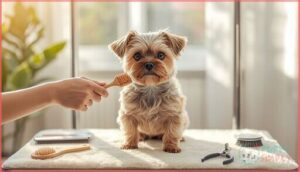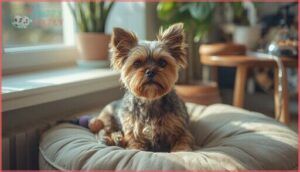This site is supported by our readers. We may earn a commission, at no cost to you, if you purchase through links.
The Brussels Griffon dog packs more personality into its 8-pound frame than most dogs twice its size. This Belgian breed started as a scrappy stable dog catching rats in the 1800s, but European royalty fell so hard for these expressive little companions that they transformed into one of the continent’s most coveted lap dogs.
With their signature human-like faces and “Velcro dog” reputation for sticking to their owners’ sides, Brussels Griffons aren’t your typical toy breed. Their intelligence matches their loyalty, and they’ll study your emotions with an intensity that borders on uncanny.
If you’re considering bringing one of these compact companions into your life, understanding their unique needs—from their respiratory quirks to their separation anxiety tendencies—makes all the difference between a struggling household and a thriving partnership.
Table Of Contents
- Key Takeaways
- Brussels Griffon Origins and History
- Physical Characteristics of Brussels Griffons
- Temperament and Personality Traits
- Health and Grooming Needs
- Care, Exercise, and Living Requirements
- Frequently Asked Questions (FAQs)
- Are Brussels Griffons prone to separation anxiety and how can it be managed?
- Are Brussels Griffons good with young children?
- How much does a Brussels Griffon puppy cost?
- Do Brussels Griffons get along with other dogs?
- What is the average lifespan of a Brussels Griffon?
- Can Brussels Griffons tolerate cold weather climates?
- Conclusion
Key Takeaways
- Brussels Griffons form intense “Velcro dog” bonds with their owners but are highly prone to separation anxiety (47% show distress behaviors), making them unsuitable for people who work long hours away from home.
- Their brachycephalic (flat-faced) anatomy creates serious health vulnerabilities, including respiratory problems, heat sensitivity, and eye injuries that require proactive veterinary monitoring and climate-controlled living environments.
- Despite their 8-10 pound size, these dogs need consistent mental stimulation and 30-45 minutes of daily exercise, plus they excel as apartment companions when their moderate barking is managed through positive reinforcement training.
- Rough-coated Brussels Griffons require hand-stripping twice yearly and regular brushing, while all variants need daily teeth brushing due to crowded dentition that accelerates dental disease and affects organ health.
Brussels Griffon Origins and History
The Brussels Griffon’s story starts in the cobblestone streets of 19th-century Belgium, where scrappy little dogs caught rats in stables and kept coachmen company. What began as a working breed transformed into a royal favorite through careful breeding and a bit of royal influence.
Let’s look at how this distinctive breed came to be and why it captured hearts across the globe.
Development in 19th Century Belgium
Back in the early 1800s, Brussels coach drivers relied on Griffons d’Ecurie—scrappy stable dogs—for rat control. But by the 1870s, everything changed. Royal influence from Queen Marie Henriette transformed these working dogs into fashionable companions. Breed standardization kicked off in 1883 when Belgium’s LOSH officially registered the first Brussels Griffon, marking a new era:
- Crossbreeding effects with Pugs and English Toy Spaniels refined their look
- Export surge to England and the U.S. began before 1900
- Brussels Griffon puppies quickly became status symbols among Belgian aristocracy
The breed has a rich history in Flemish art.
Influential Ancestor Breeds
Four distinct ancestral breeds shaped the modern Brussels Griffon you know today. Affenpinscher influence introduced the wiry facial hair and sturdy build—genetic analysis confirms 17% DNA presence. Pug heritage created the flat face and smooth coat variety, traceable in 11–15% of the genome. Spaniel contributions brought red and black-and-tan colorations, while Belgian street dogs (Griffons d’Ecurie) provided the foundational 40–45% genetic layer for resilience and vermin control.
These dogs often require regular veterinary checkups to maintain their health.
Royal Patronage and Early Recognition
Queen Henriette’s kennels transformed the Brussels Griffon from stable dog to royal status in 1894. Her courtiers couldn’t resist these expressive companions, sparking international demand. Belgium registered its first Griffon in 1883, establishing the breed standardization process. By 1889, early dog shows featured dedicated Griffon clubs, and population trends soared—nearly 5,000 bitches existed pre-WWI, cementing the global status of this charming breed.
- Aristocrats parading Griffons through gilded palace halls
- Hand-striped show coats gleaming under gaslight chandeliers
- Leather-bound studbooks recording each royal lineage
- Steam trains carrying export puppies across European borders
- Crowded exhibition benches at Westminster’s inaugural Griffon classes
Rise in Global Popularity
Following royal endorsement, the Brussels Griffon personality captured hearts worldwide. The 1997 film “As Good as It Gets” sparked a measurable adoption surge through media influence, while urban adoption trends accelerated as apartment dwellers discovered the breed’s hypoallergenic appeal.
Show recognition solidified at Westminster, and demographic shifts toward single-person households propelled this Brussels Griffon breed overview into modern relevance—compact companions perfectly suited for contemporary living spaces.
Physical Characteristics of Brussels Griffons
Brussels Griffons pack a lot of personality into a small, sturdy frame. Their unique look sets them apart from other toy breeds, with features that range from their compact build to their unforgettable faces.
Let’s break down what makes these dogs so distinctive in appearance.
Size, Weight, and Body Structure
Your Brussels Griffon will stand just 7–8 inches tall at the shoulder when fully grown, with males occasionally reaching 10 inches. Adult weight generally falls between 8–10 pounds, though some healthy dogs range from 6–12 pounds. This toy breed boasts a square, compact body with especially dense bones for its size.
Puppies weigh around 3–4 pounds at three months and continue filling out their sturdy frame until age three or four.
Distinctive Facial Features
You’ll recognize a Brussels Griffon by its striking, almost human-like face, shaped by distinctive brachycephalic features. The skull is large and domed, accounting for nearly 25% of body length.
Wide-set, round eyes sit level with an extremely short muzzle—just 1.5 cm long—while the undershot jaw creates that signature expressive look. High-set ears and a black nose complete this breed’s unforgettable dog appearance.
Coat Types and Color Variations
Your Brussels Griffon will sport one of two coat types: rough or smooth coats. The rough coat feels wiry with that signature beard, while the Smoothcoated Brussels Griffon has short, glossy fur.
Coat Genetics determine four Color Standards:
- Red—ranging from deep mahogany to lighter russet
- Belge—grizzled black and reddish-brown mix
- Black and tan—black with reddish-brown markings
- Solid black
Grooming Methods differ dramatically: rough coats need hand-stripping for Coat Maintenance, while smooth coats require simple brushing.
Temperament and Personality Traits
Brussels Griffons pack a big personality into a small body. These dogs form deep bonds with their families and bring both charm and challenge to your home.
Here’s what you can expect from their temperament and how they interact with the world around them.
Affectionate and Loyal Nature
If you’re looking for a dog who’ll stick to you like glue, the Brussels Griffon won’t disappoint. Often called “Velcro dogs,” these loyal companions form intense bonds with their families and crave constant human interaction. Their affectionate behavior includes following you room to room, cuddling close, and responding sensitively to your emotions. Despite their small size, their protective instincts make them devoted watchdogs who’ll alert you to strangers. This emotional responsiveness creates a deeply rewarding relationship, though it means they don’t handle alone time well and can develop separation anxiety when isolated for extended periods.
Brussels Griffons are intensely loyal Velcro dogs who form deep bonds with their families but struggle with separation anxiety when left alone
| Affectionate Trait | Behavioral Expression | Owner Consideration |
|---|---|---|
| Strong attachment | Follows owners closely throughout the day | Requires consistent companionship |
| Emotional sensitivity | Responds adaptively to human moods | Needs gentle, positive handling |
| Protective loyalty | Vocalizes alerts to unfamiliar situations | May be wary with strangers initially |
| Physical affection | Seeks lap sitting, cuddling, leaning contact | Less tolerant of rough play from children |
Intelligence and Trainability
These smart little dogs surprise many with their cognitive skills, but their training methods need a gentle touch. Brussels Griffon training requires positive reinforcement—harsh corrections trigger emotional sensitivity and shutdown behaviors.
While their learning speed impresses during brief, varied sessions, behavioral challenges like stubbornness and difficult housebreaking demand patience.
Their intelligence shines brightest when you combine mental stimulation with consistent, reward-based Brussels Griffon training tips that respect their sensitive nature.
Socialization With People and Pets
Think of your Brussels Griffon as a velcro companion—these dogs form intense social bonds with family members and thrive on human connection. Early socialization between 3-14 weeks shapes their Brussels Griffon temperament and behavior with strangers.
When introducing Brussels Griffons and other pets, supervised gradual introductions work best. They excel as family pets with older children but need gentle handling due to their small size and sensitivity.
Watchdog Abilities and Barking Tendencies
Your Brussels Griffon’s alert nature makes them excellent watchdogs—they’ll bark to notify you of doorbells, strangers, or unusual sounds. While their Brussels Griffon temperament and behavior includes moderate vocalization, proper watchdog training and bark control techniques reduce unnecessary noise.
Understanding barking triggers helps you manage their alert systems effectively, transforming protective instincts into purposeful communication rather than excessive vocalization.
Health and Grooming Needs
Brussels Griffons are generally healthy dogs, but their unique build comes with a few breed-specific concerns you should know about.
Their grooming needs vary depending on whether you have a rough or smooth coat, and both types require consistent care to stay comfortable and looking their best.
Let’s walk through the most important health issues to watch for and what you’ll need to do to keep your Griffon in top shape.
Common Health Issues
Despite their charm, Brussels Griffons face several health concerns you’ll want to monitor. Their flat faces cause respiratory problems, while prominent eyes invite eye infections and injuries. Skin allergies and dental issues frequently trouble this breed due to crowded teeth. Heart conditions, particularly mitral valve disease, affect aging Griffons.
Regular veterinary check-ups help catch these dog health issues early, protecting your companion’s quality of life.
Grooming Requirements for Coat Types
Your Brussels Griffon’s grooming requirements depend entirely on coat type. Rough-coated dogs need hand stripping twice yearly and brushing 2-3 times weekly with a natural bristle brush to maintain their wiry texture. Smooth-coated Griffons require less maintenance—just weekly brushing with a soft brush.
Both types benefit from bathing every 4-6 weeks, regular nail trimming every three weeks, and weekly ear cleaning to prevent infections.
Dental and Eye Care
Beyond coat care, your Brussels Griffon’s brachycephalic dentition demands daily brushing—crowded teeth trap food debris, accelerating dental disease. Brush with vet-approved toothpaste and schedule professional cleanings to protect heart and kidney health.
Their prominent Griffon vision features also need monitoring for signs like redness or tearing, as eye injuries happen easily. Regular check-ups catch cataracts and corneal ulcers early, where feature impacts become preventative practices protecting Brussels Griffon health long-term.
Tips for Preventative Health Maintenance
To safeguard your Brussels Griffon’s health issues before they escalate, focus on prevention through consistent routines:
- Dental hygiene and weight monitoring: Daily brushing prevents periodontal disease; portion control prevents obesity-related joint stress
- Joint supplements and parasite prevention: Glucosamine aids mobility; monthly preventatives protect against heartworm and fleas
- Allergy management: Monitor skin reactions to food or environmental triggers
These Brussels Griffon grooming requirements and dog health practices minimize common health problems effectively.
Care, Exercise, and Living Requirements
Your Brussels Griffon doesn’t need marathon training sessions, but they do need the right balance of activity, nutrition, and companionship to thrive. These little dogs pack big personalities into compact bodies, so understanding their daily needs helps you create a living situation that works for both of you.
Let’s look at what it takes to keep your Griffon happy, healthy, and well-adjusted in your home.
Daily Exercise and Mental Stimulation
Your Brussels Griffon needs 30 to 45 minutes of daily exercise to stay healthy and happy. Daily walks provide physical activity, while puzzle toys and scent games challenge their sharp minds. Indoor play sessions work great when the weather doesn’t cooperate. Off-leash time is fine in safe spaces if your dog has reliable recall.
Regular exercise and mental stimulation reduce unwanted behaviors like excessive barking. These activities help your Brussels Griffon release energy constructively while strengthening your bond through positive reinforcement training methods.
| Physical Activity | Mental Enrichment |
|---|---|
| Daily leash walking (consistent times) | Puzzle toys for problem-solving |
| Indoor play sessions | Scent games and nose work |
| Agility and obedience training | Learning new tricks and commands |
Diet and Nutritional Guidelines
Since your Brussels Griffon has a sensitive digestive system, you’ll want to choose high-quality dog food with animal-based proteins like chicken, beef, or fish. Feed two to three small meals daily—about 0.9 to 1.1 cups total—to manage caloric intake and prevent obesity.
- Prioritize nutrient balance with proper fats, carbohydrates, and omega-3s
- Watch for food allergies and avoid harmful ingredients like garlic or grapes
- Include prebiotic fibers like sweet potato for digestive health
- Adjust portions based on your dog’s ideal weight, not current weight
- Follow meal planning guidelines suited to your Brussels Griffon’s life stage
Suitability for Apartment Living
Brussels Griffons rank among the best small dog breeds for apartment living. Their compact size fits tight spaces, while moderate exercise needs adapt to indoor play sessions.
You’ll find their dog temperament friendly yet alert—ideal for communal buildings. Noise levels stay manageable with proper dog behavior training.
Just make sure to maintain climate control, since their flat faces make them sensitive to heat. Socialization tips: introduce neighbors early to build confidence in your Brussels Griffon’s dog exercise routine.
Managing Separation Anxiety
Small companion breeds like yours bond intensely with owners, putting them at higher risk for separation distress. Early intervention matters—dogs showing signs before 16 weeks respond 44% better to training techniques than older cases.
Build independence through:
- Short, calm departures with low-key arrivals
- Puzzle feeders and interactive toys for environmental enrichment
- Desensitization practice four times weekly
Owner consistency in dog training reduces vocalization by 29%. Medication options like fluoxetine boost success rates when paired with behavior modification, though under 7% of owners pursue this initially.
Frequently Asked Questions (FAQs)
Are Brussels Griffons prone to separation anxiety and how can it be managed?
Yes, Brussels Griffons are highly prone to separation anxiety—studies show 47% of owners report distress behaviors.
Their “Velcro dog” nature demands constant companionship, making them vulnerable when left alone for extended periods.
Are Brussels Griffons good with young children?
Most families with toddlers should reconsider this breed. Your Brussels Griffon’s small size and sensitivity make rough play risky.
They thrive with older children who understand gentle handling and respect boundaries.
How much does a Brussels Griffon puppy cost?
You’ll pay between $3,000 and $3,800 for Brussels Griffon puppies from breeders, while champion bloodlines push costs past $4, Regional pricing varies—Southern California runs higher than Texas. Adoption through rescue offers $200–$500 alternatives.
Do Brussels Griffons get along with other dogs?
Your Brussels Griffon’s success with other dogs depends heavily on early socialization and training techniques. About 60% adapt well when introduced gradually, though their alert temperament and owner experience greatly influence breed compatibility and pet compatibility outcomes.
What is the average lifespan of a Brussels Griffon?
You can expect your Brussels Griffon to live 12 to 15 years with proper care. Lifespan factors like genetics, health problems, and preventative care influence breed longevity and overall dog lifespan expectations.
Can Brussels Griffons tolerate cold weather climates?
Their short snouts and small bodies don’t handle cold well. Brussels Griffons need protective clothing and limited outdoor time in freezing weather. Keep them warm indoors to prevent respiratory issues.
Conclusion
Think of the Brussels Griffon dog as a mirror with a heartbeat—these pint-sized companions reflect your emotions right back at you with startling accuracy.
Their needs aren’t complicated, but they’re non-negotiable: consistent grooming, proactive health monitoring, and your physical presence.
If you can meet these requirements without hesitation, you’ll gain a shadow that follows you everywhere and a bond that redefines what “loyal companion” actually means.













